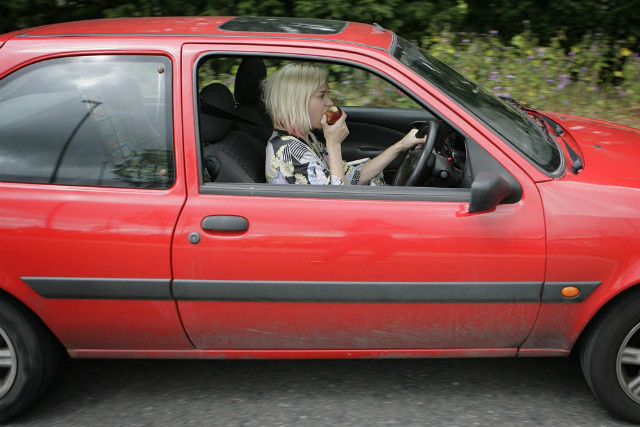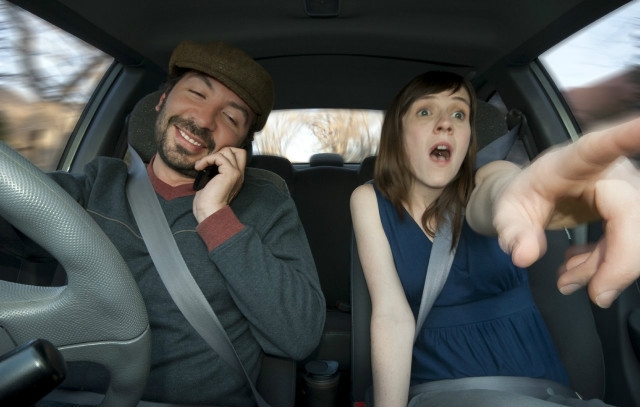The term distracted driving refers to all the different ways someone may be diverted from the primary task of driving while on the move behind the wheel of their vehicle.
Any sort of distraction a driver may experience, whether it be deliberate or not, puts not just the same driver at risk, but also any passengers onboard and other nearby motorists and bystanders.
Because of the dangers involved, it’s important for motorists to know the different type of distracted driving and what qualifies as such a thing, so they can avoid such behaviour themselves.
Types of distracted driving
The different examples that can be used to define distracted driving fall into three main categories. Certain activities can fall under more than one main category.
Visual: taking your eyes off the road
Visual driving distractions refer to any activity than can cause you to stop looking at the road ahead for any period of time while you are driving.
Examples of visual driving distractions can include changing the radio station, fiddling with a sat-nav, adjusting temperature controls or looking for items on the floor of the car or in a cubby hole etc.
Manual: taking your hands off the wheel

Manual driving distractions are those which cause the driver to take one or both hands off the steering wheel while on the move.
Some things mentioned above like adjusting temperature controls or the radio station mentioned can fall under this category, as well as other activities such as eating or drinking, smoking or texting.
Using your mobile phone to text while driving is particularly dangerous since it’s not just a manual distraction but can be categorised as a visual and cognitive one too.
Cognitive: taking your mind off driving
Cognitive driving distractions are those which cause your mind to drift away from your driving, meaning you’re not entirely focused on what you’re doing with the car’s controls or your current surroundings.
Types of distractions which fall under this particular category include talking to other passengers, daydreaming, road rage and being under the influence of alcohol or drugs.
Being drowsy could be considered a type of cognitive distraction, although some would argue drowsy driving is its own separate issue.
Examples of distracted driving
Some examples of activities which create distracted driving have already been mentioned above, but which are the most common?
A survey in America by the AAA Foundation for Traffic Safety thoroughly analysed the behaviour of drivers to determine what percentage engaged in potentially distracting activities during three hours of driving. They also observed the duration of these activities when their vehicles were moving. Their findings produced distracted driving statistics like these in the table below:
| Potential Distraction | % of Subjects | % of Total Driving Time |
| Talking on a mobile phone | 30 | 1.3 |
| Answering a mobile phone | 15.7 | 1.3 |
| Dialling on a mobile phone | 27.1 | 1.3 |
| Eating, Drinking, Spilling | 71.4 | 1.45 |
| Preparing to eat or drink | 58.6 | 3.16 |
| Manipulating music/audio controls | 91.4 | 1.35 |
| Smoking | 7.1 | 1.55 |
| Reading or Writing | 40 | 0.67 |
| Grooming | 45.7 | 0.28 |
| Baby distracting | 8.6 | 0.38 |
| Child distracting | 12.9 | 0.29 |
| Adult distracting | 22.9 | 0.27 |
| Conversing | 77.1 | 15.32 |
| Reaching, leaning, etc. | 97.1 | 3.78 |
| Manipulating vehicle controls | 100.0 | 3.78 |
| Other internal distraction | 67.1 | 3.78 |
| External distraction | 85.7 | 1.62 |
What age group has the greatest proportion of distracted drivers?
Past research by motoring groups in Britain has suggested that young drivers aged between 17 and 24 are the most susceptible to becoming distracted while behind the wheel.
Being distracted has a significant impact on the safety of young drivers, with past research from Brake finding that young drivers are six times more likely to have a serious crash when there is a loud conversation in the vehicle.
Statistics on distracted driving

One particularly large study which details how drivers behave behind the wheel and how distracted they get is the 100-Car Naturalistic Study in the USA.
This study recorded the activities of 241 drivers over the course of 12-13 months and around 42,300 hours of driving data was collected with around 2 million miles covered by the vehicles studied. By the end of the study, researchers had 5 police-reported and 67 non-police reported crashes to study, plus 761 near-crashes and 8,395 'incidents'.
It was found that 78 percent of the crashes and 65 percent of near crashes had one form of inattention or distraction as a contributing factor - including inattention because of fatigue.
Distracted driving consequences
Distracted driving can potentially lead to penalty points, fines and possible even more severe punishments in court, especially if distracted driving leads to an accident and/or is observed by police.
Of course, driving while using a handheld mobile phone is one of the more well-known examples of distracted driving which can lead to a fine and penalty points. Any example of distracted driving, whichever main category it falls under, can lead to penalty points or more if police observe that you are driving your vehicle without being in full control or without due care and attention.
You can learn more about how many penalty points can be given for different types of distracted driving in our separate guide here.
How to prevent distracted driving
Simply put, the way to avoid the potential dangers of distracted driving is to focus purely on your driving while behind the wheel of your vehicle. Refraining from activities which could distract you from driving in some way is more difficult for some than others and certain circumstances can add to the difficulty.
The best way to minimise risk when you are, say, adjusting temperature controls or checking your infotainment screen, is to do such activities when the road is straight and uncluttered, meaning there’s probably less you need to stay alert about.
If there is an activity you really want to do that would distract you from driving in either a visual, physical or cognitive manner for an extended period of time, you are better off finding somewhere you can safely pull into first.



